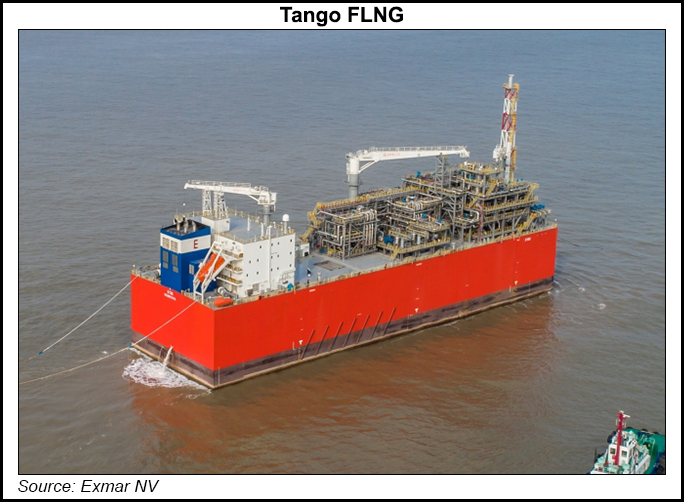NGI The Weekly Gas Market Report | E&P | NGI All News Access
Vaca Muerta Boom Leads to First LNG Out of Argentina; More to Come
Argentina in June started exporting liquefied natural gas (LNG) for the first time in its history, marking a new milestone for the Vaca Muerta shale formation in Neuquén province and a portent of much more to come.

The LNG was produced on Exmar NV’s floating LNG production barge called Tango FLNG, at the Bahía Blanca port, and using natural gas piped in from Vaca Muerta in Western Argentina. The vessel has production capacity of 500,000 metric tons, or about 0.07 Bcf/d, and could produce up to eight LNG export cargoes per year, according to the U.S. Energy Information Agency (EIA).
Shale gas production has surged in Argentina from its Vaca Muerta deposit, more than tripling between January and December 2018, from 0.3 Bcf/d to 1.0 Bcf/d. Although government subsidy programs supporting shale and tight gas production were suspended in January, gas production continues to rise.
Natural gas production in May was 7.6% higher than in the same month last year, according to Argentina’s Economy Ministry. Energy Secretary Gustavo Lopetegui projects that Argentina should achieve an energy trade balance this year and a $2 billion surplus in 2021.
The LNG is in addition to a new year-round pipeline export agreement with Chile, following the start of seasonal shipments across the Andes mountains last year.
Rising natural gas production in Argentina, coupled with competitive global LNG transportation costs, is expected to position the country as an emerging source of gas supply to Asia during peak demand periods, according to Wood Mackenzie.
“Global LNG demand is showing increasing seasonality, and peak potential LNG production in Argentina during the summer months coincides with strong winter demand from utilities in Asia. This seasonal dynamic could attract Asian buyers and present a strong economic case for Argentinian LNG.
“In addition, Argentinian LNG liquefaction plants have lower shipping costs to reach Asian markets than US Gulf Coast facilities, avoiding potential Panama Canal congestions and presenting an overall cheaper alternative to U.S. exports.”
Wood Mackenzie sees Argentina LNG ramping in 2024 with LNG production volumes reaching 6 million tons per annum (mtpa), which could then grow to 10 mtpa by 2030.
“Associated gas from Vaca Muerta will also represent 15% of Argentina gas production by 2024, and other projects in the condensate and dry gas window with breakevens below US$3/MMBtu will enter into full development in the upcoming years.
“Despite other price challenges posed by the seasonal utilization of LNG plants, Wood Mackenzie estimates breakevens for Argentina LNG of US$8/MMBtu at delivery” in a Japan port.
Natural gas storage could help solve seasonality. “Argentina will still have to import natural gas during the May to September period when natural gas demand peaks,” said the EIA. Argentina currently does not have large-scale natural gas storage facilities, and natural gas producers “have had to shut-in surplus production to accommodate the shifting seasonal consumption patterns.”
In May, Argentine national oil company YPF SA’s management team said it was pulling back on upstream natural gas investment for now, pending the resolution of a local supply glut and the development of LNG terminals.
Argentina is conducting feasibility studies to identify potential storage sites. It also is set to tender a new $1.5 billion pipeline to Buenos Aires to help deal with infrastructure shortfalls.
Vaca Muerta’s production is growing at such a rate that “not even the domestic demand and exports to neighbouring countries such as Chile and Brazil are enough for Vaca Muerta’s gas potential. LNG exports could be a solution that enables Vaca Muerta’s production to continue the growth story,” said Mauro Chavez Rodriguez, principal analyst, Latin America Gas and LNG at Wood Mackenzie.
The new Mercosur-European Union trade agreement could also facilitate LNG trade from Argentina to European markets.
Despite Argentina’s economic woes, there are no signs that development of the deposit will slow any time soon.
ExxonMobil Corp. said in early June that it would proceed with a long-term oil development in Argentina’s Bajo del Choique-La Invernada block in Vaca Muerta formation on encouraging results from a pilot project.
The project is expected to produce up to 55,000 boe/d within five years and include 90 wells, a central production facility and export infrastructure connected to the Oldeval pipeline and refineries.
“We are encouraged by the excellent results of our Neuquén pilot project and look forward to increased production through this significant expansion,” said Senior Vice President Staale Gjervik, who oversees the unconventional business.
“The reforms implemented by the federal and provincial governments have been critically important to enabling the development of the Vaca Muerta Basin as one of the country’s main energy resources.”
If the expansion is successful, ExxonMobil could invest in a second phase, which would produce up to 75,000 boe/d. Timing of the second phase would depend on initial project performance and business and market conditions, among other factors.
ExxonMobil Exploration Argentina is leading its unconventional operations in the Neuquén basin under a joint venture agreement with Qatar Petroleum, which has 30% in ExxonMobil upstream affiliates in Argentina. Many of the largest operators in the world are working in Argentina, with most in Vaca Muerta. Chevron Corp. earlier this year launched a pilot program on 162,000 net acres in the northern part of the formation. It is joined by operators that include BP plc, Royal Dutch Shell plc, Equinor ASA and Petroliam Nasional Berhad.
But Argentina also has a general election later this year. Current president Maurcio Macri, who has done much to reverse the fortunes of the energy sector, will face an uphill battle to win a second term as the country fights soaring inflation, a badly wounded currency and a recession.
© 2024 Natural Gas Intelligence. All rights reserved.
ISSN © 2577-9877 | ISSN © 2577-9966 | ISSN © 1532-1266 |
